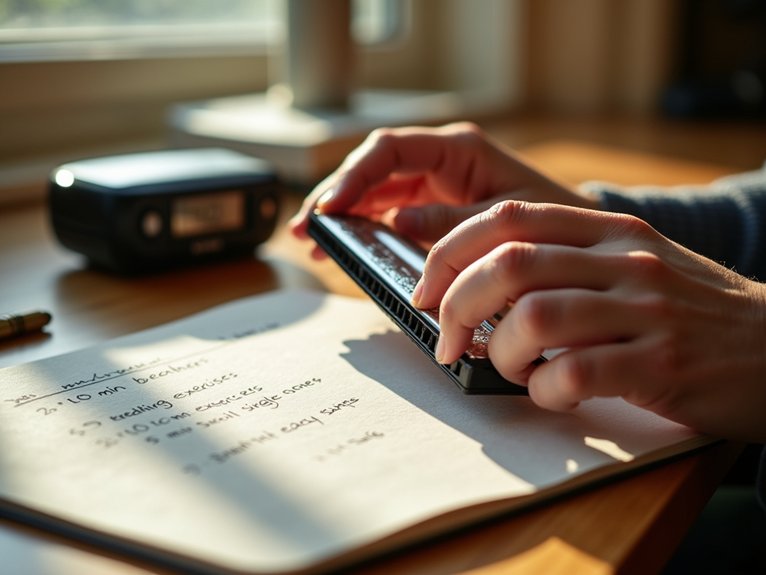Learning harmonica independently starts with acquiring a 10-hole diatonic harmonica in C. Beginners should practice 15-20 minutes daily, focusing on proper embouchure, single notes, and breathing techniques. Daily practice should include scales, breath control exercises, and learning simple melodies. Online resources like YouTube tutorials, dedicated websites, and method books provide structured guidance. Recording practice sessions helps track progress. The journey to harmonica proficiency continues with consistent practice and exploration of increasingly complex techniques.
Choosing Your First Harmonica: Types and Keys

When beginning the journey of harmonica playing, selecting the right instrument becomes a critical first step. For beginners, a 10-hole diatonic harmonica in the key of C is recommended. This versatile option suits most popular music and learning materials.
Harmonicas come in three main types: diatonic (standard blues/folk), chromatic (jazz/classical), and tremolo (folk/Asian music). While chromatic offers more notes, its complexity may overwhelm novices.
Quality matters—mid-range instruments (€28-47) from Hohner, Lee Oskar, or Suzuki provide better tone and playability than cheaper alternatives. A proper harmonica will produce clearer notes and maintain tuning longer, substantially enhancing the learning experience.
Understanding Basic Harmonica Techniques and Terminology
With your harmonica now selected, mastering fundamental techniques and vocabulary forms the foundation of playing success. Begin by understanding these essential terms:
- Embouchure: The proper lip positioning around the harmonica
- Draw: Inhaling or breathing in through the instrument
- Blow: Exhaling or breathing out through the instrument
- Single note: Playing one hole at a time (achieved by „puckering”)
- Tongue blocking: Covering multiple holes with your tongue to isolate notes
- Bending: Manipulating pitch by changing mouth cavity shape
- Position playing: Different playing positions (first position/straight harp, second position/cross harp)
Practice proper breathing control and diaphragm engagement for sustained notes and improved tone production.
Essential Practice Routines for Beginners

How does a beginner transform theoretical knowledge into practical harmonica skills? Through consistent, structured practice routines that build fundamental abilities.
Beginners should dedicate 15-20 minutes daily to single-note practice, focusing on clean notes without airflow waste. Breath control exercises—alternating between soft and loud notes—develop essential dynamics. A metronome helps establish timing precision starting at slow tempos (60 BPM).
Simple scale practice builds finger dexterity and position awareness. Recording practice sessions allows self-assessment of progress. Learning one simple melody weekly reinforces technique application in musical context, providing measurable benchmarks for improvement.
Learning Your First Songs and Riffs
The application of consistent practice routines naturally leads to the rewarding stage of playing actual music. Beginners should start with simple, recognizable melodies that require minimal note changes. Folk songs like „Oh Susanna” and blues standards offer accessible starting points.
When learning songs, break them into small phrases rather than attempting entire pieces at once. Practice each section slowly before increasing tempo. Focus on clean note shifts and proper breathing techniques throughout.
Single-note riffs from recognizable songs build confidence while teaching fundamental skills. Recording practice sessions allows harmonica students to track progress and identify areas needing improvement as they develop their repertoire.
Resources for Self-Taught Harmonica Players

Where can aspiring harmonica players turn when learning independently? Numerous resources exist to support self-taught musicians. Online platforms like YouTube offer free tutorials from experienced harmonica players, while dedicated websites such as Harmonica.com and ModernBluesHarmonica.com provide structured lessons and tablature.
Printed materials remain valuable; method books by David Harp, Jon Gindick, and Dave Barrett offer systematic approaches to learning. Digital apps like Harmonica Boot Camp and Simply Harmonica provide interactive lessons with real-time feedback.
Online communities, including forums and social media groups, connect beginners with experienced players who share advice and encouragement. Local music stores often stock instructional materials and can recommend additional resources.



